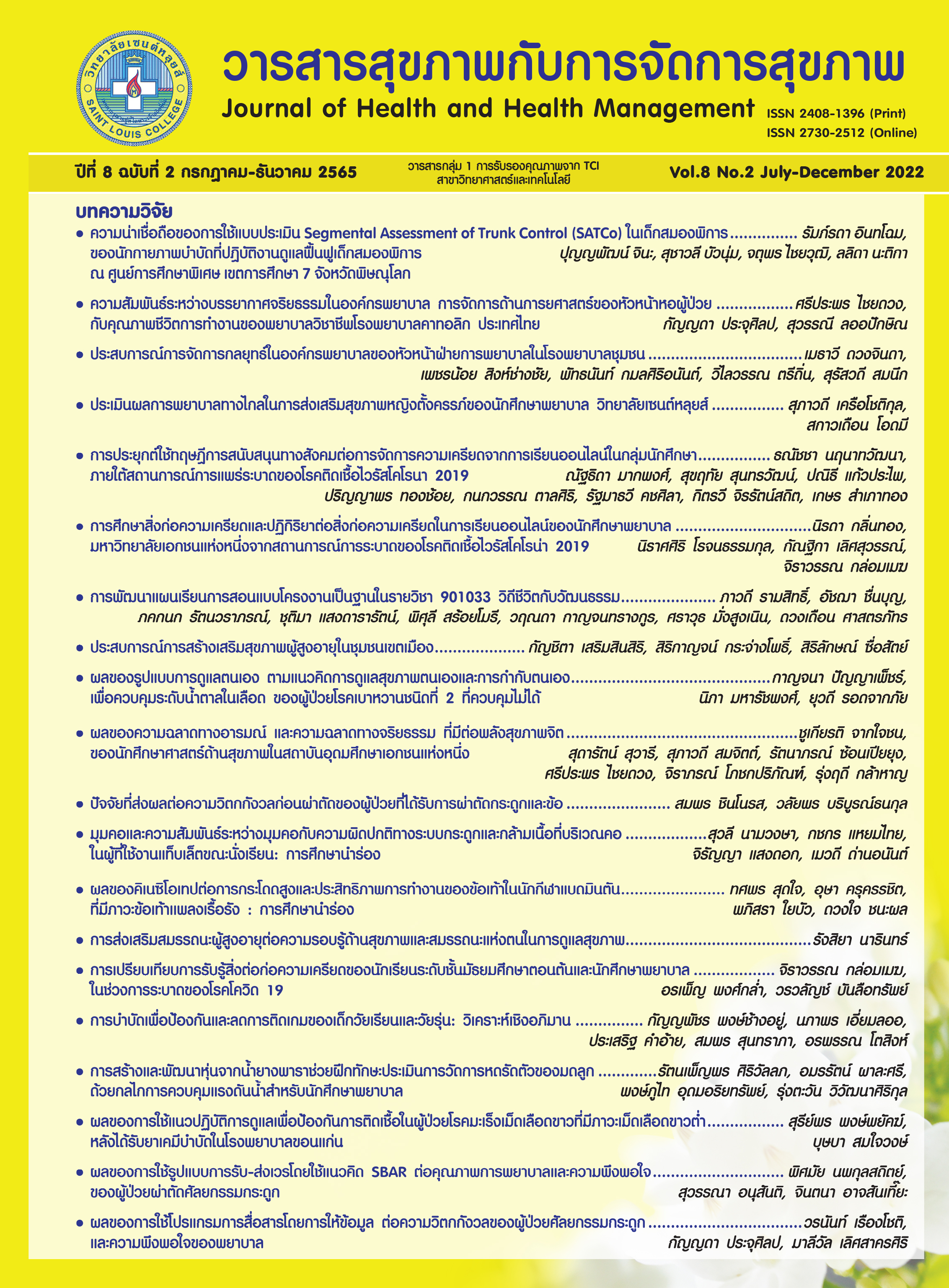Cervical Angles and the Relationship between Cervical Angles and Neck Disorders during Tablet Usage while Sitting in Class: A Pilot Study
Keywords:
Cervical angle, neck disorders, Tablet users, sitting in class, Pilot studyAbstract
The purpose of this study was to determine the cervical angles during tablet usage while sitting in class. The relationship between these cervical angles and neck disorders was investigated with a sample group of 14 health science students from Naresuan University. A 30-minute video of a tablet being used for a study simulation was captured. The Kinovea program was used to measure the upper and lower cervical angles. Additionally, the relationship between these angles and neck musculoskeletal disorders was analyzed by Fisher's exact test. The statistical significance was set at p < 0.05. This study found that during tablet usage while sitting in class in upper cervical tiling position and lower cervical flexion position in the longest period of time, the upper cervical angle was determined to be 158.47±11.53 degrees, while the lower cervical angle was determined to be 62.66±5.26 degrees. Nevertheless, this study could not conclusively determine the relationship between these angles and neck disorders (p = 0.11 for the upper cervical angle and p = 0.59 for the lower cervical angle). This could be due to the relatively small sample size since the was a pilot study. As a result, additional research should be conducted in the future to draw definite and generalizable conclusions.
References
นันทกาญจน์ เกวี, ศศิพา ชูเเก้ว, และศิรินันท์ อุดม. (2563). การประเมินความเสี่ยงทางการยศาสตร์ของผู้ใช้งานแท็บเล็ต ในนิสิตสายวิทยาศาสตร์สุขภาพ มหาวิทยาลัยนเรศวร. (วิทยานิพนธ์ระดับปริญญาตรี). พิษณุโลก, มหาวิทยาลัยนเรศวร.
พนม. (2559). อัตราส่วนการฉาย (Throw Ratio ). สืบค้นจาก https://projectorweb.wordpress.com/2016/05/14/
พฤทธิพงศ์ สามสังข์, สุภารัตน์ คะตา, ธนกฤต ธนวงศ์โภคิน, ณัฐจิต อ้นเมฆ, และปานฤทัย ไชยสิทธิ์. (2562). การศึกษาปัจจัยเสี่ยงด้านการยศาสตร์กับอาการไม่สบายทางระบบกระดูกและกล้ามเนื้อ กรณีศึกษากลุ่มผู้ทาเครื่องเบญจรงค์บ้านดอนไก่ดี จ.สมุทรสาคร. สมุทรสาคร: สำนักวิจัยและพัฒนา สถานบันส่งเสริมความปลอดภัย ชีวอนามัย และสภาพแวดล้อมในการทำงาน.
โยษิตา โมราสุข, พัณณิตา สุขวิเศษ, และวโรชา วงษ์จีน. (2562). ความชุกของความผิดปกติทางระบบกระดูกและกล้ามเนื้อของผู้ใช้งานแท็บเล็ต ในนิสิตสายวิทยาศาสตร์สุขภาพ มหาวิทยาลัยนเรศวร. (วิทยานิพนธ์ระดับปริญญาตรี). พิษณุโลก: มหาวิทยาลัยนเรศวร.
วรานุช ปิติพัฒน์. (2554). ระเบียบวิธีวิจัยทางทันตแพทยศาสตร์. ขอนแก่น: โรงพิมพ์มหาวิทยาลัยขอนแก่น.
สายสมร เฉลยกิตติ, จินตนา อาจสันเที๊ยะ, และมักเดลานาสุภาพร ดาวดี. (2563). ผลกระทบโรคระบาด COVID-19: การจัดการเรียนการสอนทางการพยาบาล. วารสารวิจัยสุขภาพและการพยาบาล, 36(2), 255-262.
สุชาดา พลาชัยภิรมย์ศิล, และเยาวภา พรพิริยะ ล้ำเลิศ. (2555). แท็บเล็ตสื่อยอดนิยมในยุคการเรียนแบบไฮบริด. Executive Journal, 32(3), 134-140.
สุพัฒน์ สุกมลสันต์. (2553). ขนาดของผล: ความมีนัยสำคัญทางปฏิบัติในการวิจัย. วารสารภาษาปริทัศน์, 25(0), 26-38.
สุวลี นามวงษา, วราภรณ์ ศรีเสือ, สุณิสา ดิษฐสร้อย, และสุภัสสรา สาโรจน์. (2565). ปัจจัยที่มีความสัมพันธ์กับความผิดปกติทางระบบกระดูกและกล้ามเนื้อของผู้ใช้งานแท็บเล็ต. เวชสารแพทย์ทหารบก, 75(2), 115-125.
อุไรวรรณ ชัชวาลย์, รุ้งทิพย์ พันธุเมธากุล, พรรณี ปึงสุวรรณ, สาวิตรี วันเพ็ญ, ยอดชาย บุญประกอบ, สุภาภรณ์ ผดุงกิจ, และมณเฑียร พันธุเมธากุล. (2556). ความชุกของอาการปวดของระบบกล้ามเนื้อและกระดูกของนักศึกษาระดับปริญญาตรีขอนแก่น. วารสารเทคนิคการเเพทย์เเละกายภาพบำบัด, 25(2), 193-202.
Castro, W.H., Sautmann, A., Schilgen, M., & Sautmann, M. (2000). Noninvasive three-dimensional analysis of cervical spine motion in normal subjects in relation to age and sex. An experimental examination. Spine, 25(4), 443-449.
David, G.C. (2005) Ergonomic methods for assessing exposure to risk factors for work-related musculoskeletal disorders. Occupational Medicine, 55(3), 190-199.
Elwardany, S.H., Eleiny, K.E.A., & Arabia, S. (2015). Reliability of Kinovea computer program in measuring cervical range of motion in sagittal plane. OALib Journal, 2(9), 1-10.
Kietrys, D.M., McClure, P.W., & Fitzgerald, G. K. (1998). The relationship between head and neck posture and VDT screen height in keyboard operators. Physical Therapy, 78(4), 395-403.
Lee, J.C., & Kim, K. (2016). The effects of screen smart devices on the neck flexion angle. Journal of International Academy of Physical Therapy Research, 7(2), 1051-1055.
Puig, A., Escalona, C., Padullés, J.M., Busquets, A., Padullés, X., & Marcos, D. (2019). Validity and reliability of the Kinovea program in obtaining angles and distances using coordinates in 4 perspectives. PloS One, 14(6), e0216448.
Downloads
Published
How to Cite
Issue
Section
License
Copyright (c) 2022 Journal of health and health management

This work is licensed under a Creative Commons Attribution-NonCommercial-NoDerivatives 4.0 International License.




